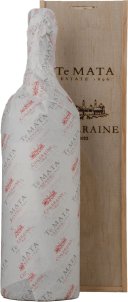Chateau Rauzan-Segla 2me cru classe
One of the original Second Growths of the Bordeaux Classification of 1855, Rauzan-Ségla's 51 hectares of mineral rich soils begin on the banks of the Gironde, on the left bank of Bordeaux. A complex mix of gravel, clay and limestone subsoil imparts a richness and complexity to the Cabernet (62%), Merlot (36%), Cabernet Franc (1%) and Petit Verdot (1%) grapes used to produce this powerfully intense and elegant wine. The estate was last sold in 1994 to the Wertheimer family of Chanel, who employed former Château Latour winemakers, David Orr and John Kolasa. Nicolas Audebert, the former winemaker at Cheval des Andes, the LVMH property in Mendoza Argentina, was hired to succeed John Kolasa following his retirement in 2014.
Cardinale Cabernet Sauvignon
Chateau Angelus, GRAND CRU CLASSE Le Carillon de l'Angelus
LE CARILLON DE L'ANGELUS Second wine of Ch. Angelus , St-Emilion
Paul Jaboulet Aine La Chapelle
Te Mata Estate Coleraine Cabernet Merlot
Te Matas Hawkes Bay estate is a prestigious winery with a rich history, producing some of New Zealands most celebrated wines. If the Langtons Classification crossed the Tasman, Te Mata Coleraine would sit alongside Grange at its very pinnacle. Established, esteemed, outstanding vintage after vintage, the glowing adjectives come thick and fast.
Pym-Rae
Shafer Vineyards Hillside Select Stags Leap District Cabernet Sauvignon
SHAFER VINEYARDS Hillside Select Stags Leap District Cabernet Sauvignon, Napa Valley
Bremerton Old Adam Shiraz
Bremerton Old Adam is a stunning example of Langhorne Creek Shiraz with dense and integrated fruit that exudes ripe plum and blackcurrant. Rebecca Willson is able to seperate each parcel of fruit that comes in off of the old vineyards and keeps them that way throughout fermentation and maturation in oak. This enables perfect barrel selection to create a wine of true distinction.
PAVILLON ROUGE DU Chateau Margaux Second wine of Chateau Margaux
The second wine of Chateau Margaux came about partly due to misfortune - when an attack of phylloxera decimated the vineyards, necessitating a replanting of the majority of their vineyards. The lack of grapes eliminated the possibility of a First Growth Quality wine and led to the production of their second wine - the Pavillon Rouge de Chateau Margaux, the first official vintage of which was released in 1906. Renowned as a sterling example of a second wine, the 2016 has been hailed as a particularly superb vintage. Medium-bodied, silky, intense and tannic, it continues its impressive trajectory year upon year.























